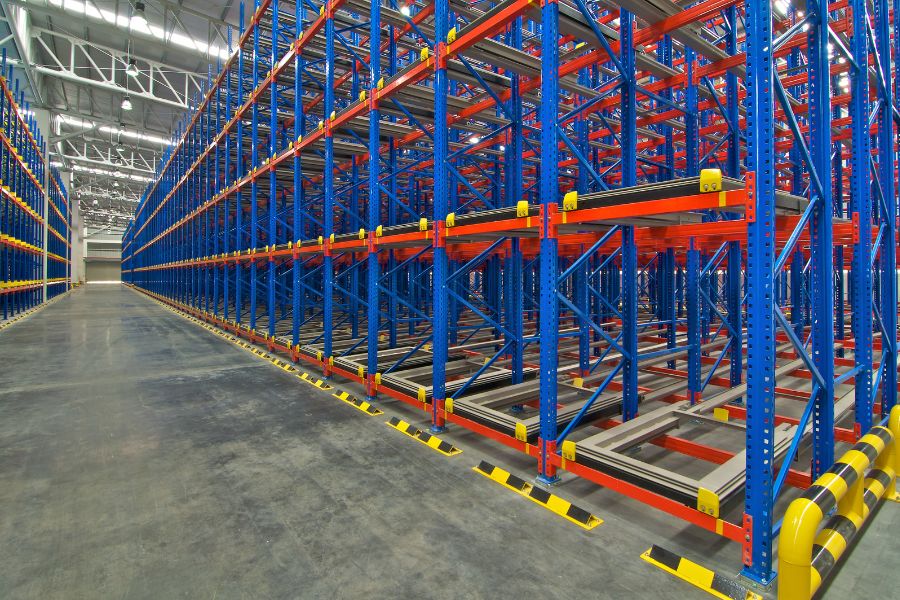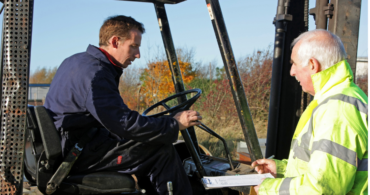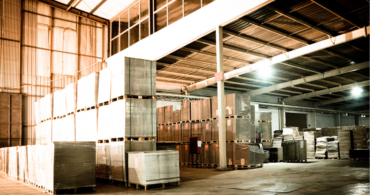With ecommerce increasing the demands for prompt and accurate order fulfillment, the modern warehouse is constantly evolving. To improve retrieval time and decrease errors, many facilities install an automated warehouse racking system.
What is ASRS?
ASRS is an easier way to say (and write) automated storage and retrieval system.
Ok, so, what is automated storage and retrieval system?
An automated warehouse storage system, also known as an automated warehouse racking system, is a warehouse setup that uses robotics and other automated mechanisms to streamline the moving and storing of inventory. An ASRS can improve operational efficiency, inventory accuracy and space utilization.
While ASRS systems reduce the need for manual labor, they only shift the role of many workers. Operators still play a crucial role in monitoring and managing an ASRS meaning adequate training is required for system maintenance, troubleshooting and emergencies.
What is automated warehouse?
An automated warehouse, also known as an automated distribution center or smart warehouse, is a facility where mechanical systems perform many operations. Automated warehouse storage systems are often integrated with warehouse management systems (WMS) or inventory management software that track inventory levels and order status in real-time.
The primary goal of an automated warehouse is to improve the efficiency and accuracy of storing, handling and distributing goods and materials. The type of inventory stored in an automated warehouse depends on several factors, including storage requirements and the order fulfillment processes. However, some inventory characteristics are best suited for automation, including high-volume, fast-moving and high-security items.
Types of automated storage and retrieval systems
There are seven main types of automated storage systems in warehouses. These technologies handle different categories, sizes and amounts of non-palletized inventory.
The seven types of ASRS include:
Vertical carousel modules (VCMs)
Vertical carousel modules (also known as vertical lift modules—VLMs) resemble tall, lengthy filing cabinets where the drawers come to you. Users retrieve inventory through a vertically sliding viewport that displays only a portion of the total content. However, before a worker can take possession of it, that inventory gets to go for a ride.
Inside a vertical carousel module are several shelves divided into sections. These shelves are attached to tracks that run along the left and right sides of the machine to move the shelves vertically. Imagine two Ferris wheels set an equal distance apart with long shelves connecting the seats, and you get the idea.
To retrieve an item, the user inputs a code (such as an SKU number) into a navigation keypad or touchscreen. The code corresponds to a specific shelf within the VCM. Once the code is entered, the machine springs to life (metaphorically, this isn’t a Terminator situation—yet), the gears whirl, the shelves move and the requested inventory is delivered through the viewport.
Horizontal carousel modules (HCMs)
Also known as horizontal carousel storage systems, a horizontal carousel module works sort of like a VLM turned on its side. However, instead of two Ferris wheels, picture the system that moves clothes around at a dry cleaner. Also, replace the neatly bagged suits, dresses, Hawaiian shirts, etc., with shelves and bins moving along the rack.
Horizontal carousel modules are also much longer than vertical carousel modules to make room for the horizontally moving shelves. When an order needs to be fulfilled, the carousel rotates and positions the appropriate bin or shelf in front of the operator.
Vertical lift modules (VLMs)
Vertical lift modules are like vertical carousel modules, except instead of a Ferris wheel apparatus, this machine operates like an elevator (“lift” is the British word for elevator). The device is a tall, vertical structure with multiple shelves of storage bins or trays stacked above each other.
However, these shelves are not attached to the moving mechanism. Instead, when an operator enters the code for a specific inventory, the elevator moves to that location and mechanically grabs the entire shelf. The machine then lowers that shelf and sets it on a work counter in front of the operator. Once the operator removes the inventory, the device returns the shelf to its original location.
Both vertical lift modules and the carousels are excellent for storing and retrieving small parts and components. They are customizable and can accommodate various tray sizes, weight capacities and inventory heights.
Crane-based mini-load ASRS
Of all the automated storage and retrieval systems discussed, the crane-based mini-load system comes closest to traditional warehouse storage racks (we hoped it was like an arcade-style crane game where you try to grab stuffed animals with a claw, but no such luck). This system consists of multiple racks with shelves that hold totes, bins or trays. However, instead of open aisles where forklifts drive and pedestrians walk, the spaces between racks are lined with rails.
When inventory needs to be stored or retrieved, an automated crane runs along these rails to the designated location. Mechanical arms reach into the racks to place or grab the item. Once retrieved, inventory is delivered to a workstation or picking station.
Vertical buffer modules (VBMs)
If a horizontal carousel module and a crane-based mini-load system had a baby, the result would be a vertical buffer module. The machine and all inventory are housed in a long, tall, rectangular casing, and an automated crane located inside the device is used to retrieve merchandise.
Instead of shelves attached to a carousel (like in an HCM), the multiple columns of shelves and trays of a VBM are adhered to the structure’s inner walls. When an operator requests an item, an automated crane moves along a single track that runs the length of the machine. The retrieved item is then delivered to the operator through a door in the VBM.
Robotic cube storage
Up to this point, everything we have described, while technologically advanced, is some variation of traditional warehouse storage with inventory retrieved from shelves. With robotic cube storage, we leave the familiar far behind.
The main feature of robotic cube storage is the multiple-level, cube-like structure filled with silos of storage containers (for you Trekkies, picture a Borg cube). There are no aisles or traditional access points. Instead, the only way to retrieve inventory is from the top of the structure, which is accomplished using robots equipped with grippers, sensors and navigation systems. These robots, which look more like a cardboard box than R2-D2 or C-3PO, roll along the top of the structure and use grippers or other specialized tools to reach into a silo and retrieve inventory. If the robots need an item in the middle of a silo, they simply remove containers until they get the correct item.
The primary benefit of robotic cube storage is that it maximizes both vertical warehouse space (because it can be built nearly to the building’s ceiling) and floor space.
Automated guided vehicles (AGVs)
Automated guided vehicles carry inventory through a facility by following a set path. Typically, the route is defined using magnetic tape or wires. If an AGV’s course needs to be changed, it must be physically modified. These machines use sensors, lasers and bumpers to detect and avoid obstacles, similar to a robotic vacuum.
Automated guided vehicles are used for repetitive and predictable tasks in a controlled environment. For example, because they follow a predefined path, AGVs are commonly used to transport products and pallets from one location to another, such as from a loading dock to a storage area.
Autonomous mobile robots (AMRs)
While an autonomous mobile robot may not look like R2-D2 or C-3PO, this system takes us closer to Star Wars than ever before because these autonomous robots work side-by-side with humans (also, AMRs would not be welcome in most cantinas).
AMRs navigate environments without needing tape or wires. These machines use advanced navigation technologies, such as cameras equipped with light detection and ranging (LiDAR) and simultaneous localization and mapping algorithms (SLAM), to navigate obstacles, adjust routes on the fly, and handle environmental changes.
In warehouses, AMRs are frequently used to transport goods and order picking. An AMR can navigate warehouse aisles, access inventory racks and deliver items to packers or shipping stations. Some AMRs can even conduct inventory counts, locate misplaced items and provide real-time inventory management.
What are the benefits of an ASRS racking system?
Automated storage systems in warehouses offer several advantages, including:
- Maximizing vertical space. ASRS racking systems can significantly increase the storage capacity of a facility by utilizing the full height of the building, which is especially valuable in high-cost real estate areas.
- Reducing aisles and optimizing available floor space. ASRS racking systems are designed to make the most efficient use of available space.
- Reducing errors by automating order picking. Automated systems are designed to follow precise instructions, which reduces mistakes like picking the wrong item or quantity, misreading labels or transposing numbers.
- Improved inventory accuracy. ASRS systems are equipped with advanced tracking and inventory management capabilities. This leads to higher inventory tracking accuracy and reduces the risk of over- or understocking and inventory discrepancies.
- Enhancing operator safety. ASRS solutions eliminate the need for employees to perform physically demanding tasks like lifting heavy items or climbing ladders and reaching up to high shelves to retrieve goods.
- Efficient management of a wide range of items. ASRS systems can accommodate different types of inventories, from small parts to large items, with minimal reconfiguration.
- Inventory security. ASRS solutions often include safety features such as access control and restricted entry. This helps prevent unauthorized access to valuable inventory, reducing the theft risk.
What are the potential downsides of an ASRS racking system?
While implementing an automated warehouse racking system can be highly beneficial, there are many factors to consider, including:
- High initial investment. ASRS systems typically require a significant upfront capital investment. This includes the cost of the hardware (racking, cranes, robots), software, integration with existing systems and installation. Many businesses may find ASRS systems cost-prohibitive.
- Complex implementation. Implementing ASRS solutions is a complex process that involves planning, design, integration and testing. Also, installation may require downtime and disrupt operations.
- Maintenance. Like all machinery, ASRS systems experience downtime due to technical issues, maintenance or system updates. Also, businesses must budget for system lifespan costs, such as ongoing maintenance and repairs.
- Not suited for frequent inventory changes or small inventories. ASRS systems are best suited for applications with stable inventory profiles and long-term storage needs. Also, businesses with small inventories or low inventory turnover may find that the complexity and cost of an ASRS system outweigh the benefits. Smaller warehouses with limited space may also find it challenging to justify the investment.
- Longer return on investment (ROI). The upfront costs of ASRS solutions may take longer for the ROI to kick in, especially for businesses with smaller inventories.
- Energy consumption. Some ASRS systems are energy-intensive, particularly cranes and robotics. Energy costs should be considered in the overall cost-benefit analysis.
It is essential to conduct a thorough analysis of a warehouse’s specific requirements and inventory characteristics before choosing an ASRS system. Additionally, since most automated storage systems in warehouses are not designed to handle palletized inventory, you’ll need to keep your forklift fleet up and running.
To help maintain your forklift fleet, Texas Motive Solutions provides a complimentary forklift fleet performance analysis and industrial battery service so your industrial trucks operate at peak efficiency. Give us a call at (888) 316-2459 or fill out this form to learn about our services and discover everything we can do for you.


